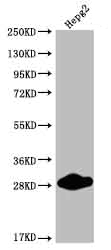The generation of the CDX1 recombinant monoclonal antibody follows a stringent and standardized process to ensure its quality and specificity. Initially, B cells are isolated from an immunized animal, using the synthesized peptide derived from human CDX1 as the immunogen. Total RNA is extracted from the B cells and converted into cDNA through reverse transcription. The CDX1 antibody genes are then amplified using specific primers targeting the antibody constant regions and inserted into an expression vector. This vector is introduced into host cells, enabling the production of the CDX1 recombinant monoclonal antibody. The antibody is harvested from the cell culture supernatant and subjected to purification using affinity chromatography, resulting in a highly purified form. Extensive characterization assays, including ELISA, WB, and IF analysis, are conducted to validate the antibody's specificity and functionality, ensuring its precise binding to human CDX1 protein. Through this meticulous production process, a reliable and effective CDX1 recombinant monoclonal antibody is generated, suitable for various applications in CDX1-related research.







